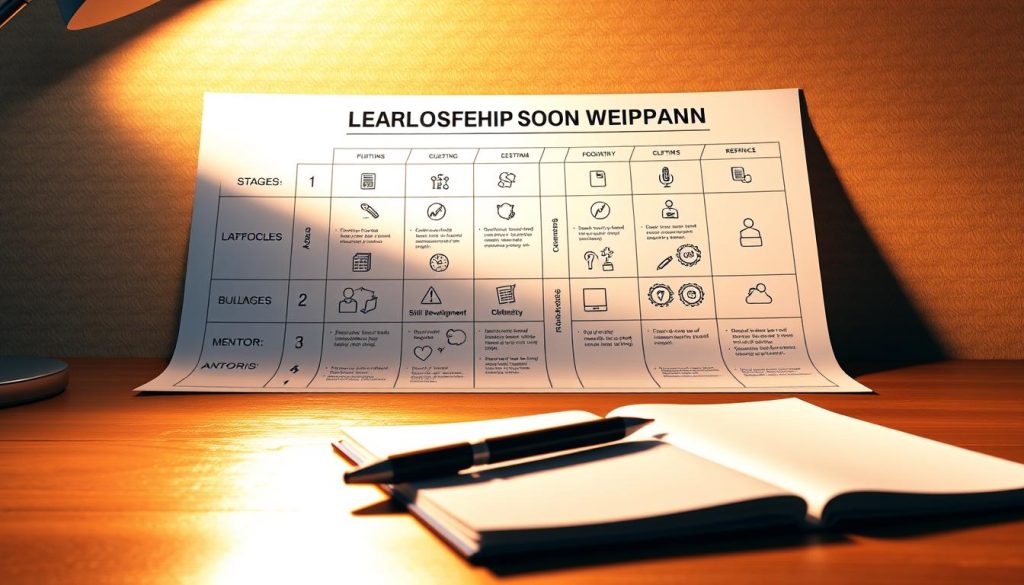Can anyone truly become a great leader, or is it a trait reserved for a select few? The truth lies in understanding that effective leadership is not an innate ability, but rather a skill developed through practice, patience, and persistence.
Developing leadership skills is a goal for many professionals, and it’s achievable by learning and implementing various leadership strategies and techniques. In this article, we’ll explore the essential strategies for enhancing your leadership development and becoming a more effective leader.
Key Takeaways
- Understanding the importance of leadership development
- Identifying key leadership skills to focus on
- Exploring strategies for effective leadership
- Learning how to implement leadership techniques
- Developing a plan for continuous leadership growth
Understanding the Foundations of Effective Leadership
Effective leadership is the backbone of any successful organization, and understanding its foundations is crucial for aspiring leaders. To lead effectively, one must first distinguish between leadership and management, understand the core qualities of successful leaders, and recognize the impact of effective leadership on organizations.
Defining Leadership vs. Management
Leadership and management are often used interchangeably, but they have distinct meanings. Management is about planning, organizing, and controlling, whereas leadership is about inspiring, motivating, and influencing others. Effective leaders understand that their role is not just to manage tasks but to inspire their teams to achieve their best.
Core Qualities of Successful Leaders
Successful leaders possess certain effective leadership qualities that set them apart. These include:
- Integrity: Leaders with integrity are honest, trustworthy, and ethical.
- Vision: The ability to have a clear vision and communicate it effectively to their team.
- Emotional Intelligence: Understanding and managing their own emotions and those of their team members.
The Impact of Effective Leadership on Organizations
Effective leadership has a significant impact on organizations. It leads to improved productivity, better employee engagement, and an enhanced reputation. Organizations with effective leaders are more likely to achieve their goals and succeed in their respective markets. Investing in leadership training can help develop these skills and qualities, ultimately benefiting the organization as a whole.
How to Become an Effective Leader Through Self-Development
Becoming an effective leader starts with a journey of self-discovery and growth. To lead others, you must first understand yourself. This involves cultivating self-awareness, developing emotional intelligence, and establishing an authentic leadership style.
Cultivating Self-Awareness and Personal Growth
Self-awareness is the foundation of effective leadership. It involves understanding your strengths, weaknesses, values, and emotions. To cultivate self-awareness, practice self-reflection regularly. This can be done through journaling, seeking feedback from others, or engaging in mindfulness practices.
- Identify areas for personal improvement.
- Set realistic goals for personal growth.
- Engage in continuous learning and development.
Developing Emotional Intelligence
Emotional intelligence is critical for building strong relationships with your team members. It involves recognizing and understanding emotions in yourself and others. To develop emotional intelligence, focus on empathy and effective communication.
- Practice active listening to understand others’ perspectives.
- Manage your emotions to respond, not react, to situations.
- Develop empathy by putting yourself in others’ shoes.
Establishing Your Authentic Leadership Style
Your leadership style should be an authentic reflection of your values, strengths, and personality. To establish your authentic leadership style, start by:
Identifying Your Strengths and Weaknesses
Understand what you bring to the table and where you need improvement. This self-awareness will help you lead more effectively.
Creating a Personal Development Plan
Outline specific steps you will take to grow as a leader. This plan should include goals, strategies for achieving those goals, and metrics for measuring success.

By focusing on self-development, you can become a more effective leader. This journey involves continuous learning, self-reflection, and growth. As you cultivate self-awareness, develop emotional intelligence, and establish your authentic leadership style, you will be better equipped to inspire and motivate your team.
Essential Communication Skills for Leadership Success
The ability to communicate effectively is crucial for leaders, as it directly impacts their ability to lead, motivate, and inspire their teams. Effective communication fosters a positive and productive team environment, driving success in various aspects of an organization.
Mastering Active Listening
Active listening is a fundamental communication skill that involves fully concentrating on what the other person is saying, understanding their perspective, and responding thoughtfully. It’s about more than just hearing words; it’s about understanding the underlying message and emotions. Leaders who master active listening can build stronger relationships with their team members, resolve conflicts more effectively, and make more informed decisions.
To practice active listening, leaders should:
- Maintain eye contact with the speaker
- Avoid interrupting and allow the speaker to finish their thoughts
- Ask clarifying questions to ensure understanding
- Paraphrase or summarize what the speaker has said to show understanding
Delivering Clear and Inspiring Messages
Leaders must be able to deliver messages that are not only clear but also inspiring. This involves understanding the audience, being aware of the context, and using appropriate language and tone. Effective leaders use storytelling techniques to make their messages more relatable and memorable.
| Key Elements | Description |
|---|---|
| Clarity | Ensure the message is straightforward and easy to understand |
| Inspiration | Use motivational language and examples to inspire action |
| Relevance | Tailor the message to the audience’s needs and interests |
Providing Constructive Feedback
Providing constructive feedback is a critical communication skill for leaders. It involves giving specific, timely, and relevant feedback that is aimed at improving performance. Constructive feedback should be delivered in a respectful and supportive manner, focusing on behavior rather than personality.
Navigating Difficult Conversations
Difficult conversations are inevitable in leadership roles. Leaders must be able to navigate these conversations with empathy, tact, and professionalism. This involves being prepared, staying calm under pressure, and focusing on finding solutions rather than placing blame.
By mastering these essential communication skills, leaders can significantly enhance their effectiveness, build stronger teams, and drive organizational success.
Building and Leading High-Performing Teams
Building a high-performing team requires a leader to foster a culture of trust, collaboration, and innovation. Effective leaders understand that the success of their organization hinges on their ability to build and lead such teams.

Creating a Culture of Trust and Psychological Safety
A culture of trust is foundational to high-performing teams. Leaders can cultivate this by promoting open communication, encouraging risk-taking, and demonstrating vulnerability. When team members feel safe to share their ideas without fear of judgment, they are more likely to contribute to the team’s success.
Effective Delegation and Empowerment
Delegation is not just about assigning tasks; it’s about empowering team members to take ownership and make decisions. Leaders should delegate based on individual strengths and provide the necessary resources and support. This not only enhances productivity but also develops leadership skills within the team.
Recognizing and Developing Team Talent
Identifying and nurturing talent is crucial for the growth and sustainability of high-performing teams. Leaders should provide opportunities for professional development, offer constructive feedback, and recognize achievements. This approach not only motivates team members but also ensures that the team remains skilled and adaptable.
Managing Conflict and Building Consensus
Conflict is inevitable in any team, but effective leaders know how to manage it constructively. By fostering an environment where diverse perspectives are valued, leaders can turn conflicts into opportunities for growth. Building consensus requires active listening, empathy, and a commitment to finding solutions that benefit the team as a whole.
In conclusion, building and leading high-performing teams is a multifaceted challenge that requires effective leadership. By creating a culture of trust, delegating effectively, recognizing talent, and managing conflict, leaders can drive their teams towards exceptional performance.
Conclusion: Your Journey to Leadership Excellence
Becoming an effective leader is a continuous journey that involves developing your leadership skills, understanding your strengths and weaknesses, and learning from your experiences. By focusing on self-development, you can cultivate the qualities necessary to succeed in leadership roles.
Effective communication is also crucial for leadership success. By mastering active listening, delivering clear and inspiring messages, and providing constructive feedback, you can build trust and motivate your team to achieve their best.
Building high-performing teams requires creating a culture of trust and psychological safety, effective delegation and empowerment, and recognizing and developing team talent. By applying these strategies, you can achieve leadership excellence and make a lasting impact in your organization.
To continue on your journey to leadership excellence, focus on ongoing leadership development. This will enable you to stay adaptable and responsive to the needs of your organization, ultimately driving success and growth. By learning how to become an effective leader, you’ll be well on your way to achieving your goals.
